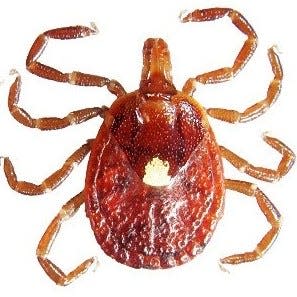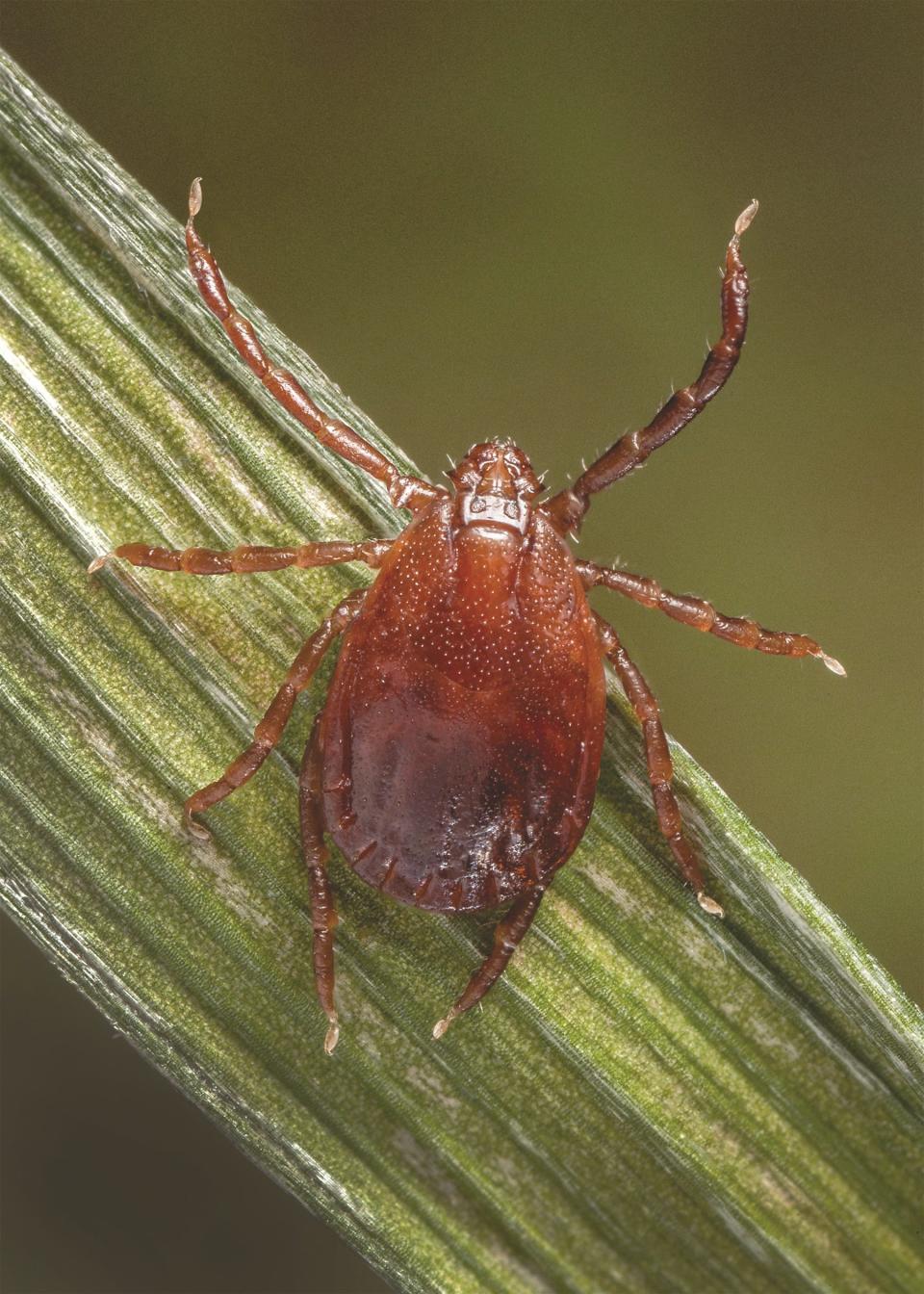Tick invaders. A warming climate brings southern species of ticks to Cape Cod & Islands
You may be looking for the quickest path to the beach.
There, a slender ribbon of sand crowded by seagrass and beach roses offers a quicker alternative to a boardwalk or a Mobi-Mat corridor farther on.
But, beware.
Ticks — clinging to the grass tips and the outstretched fingers of the rose thickets — are just waiting for someone or their pet to brush past.
Cape Cod, with its generally milder climate, is home to these blood-sucking, disease-spreading arachnids, from black-legged deer ticks to the American dog tick. But in recent years, new species of ticks have begun to move in from the South, and warmer temperatures have allowed both the newcomers and the indigenous ticks to thrive.

Barnstable County entomologist Larry Dapsis, with the Cape Cod Cooperative Extension, says if ever there was a force that could build unanimous consensus on the Cape, it's ticks.
"Everybody hates ticks," he said.
Climate change and ticks
Land use changes and habitat fragmentation have helped in the proliferation of ticks, but climate change has played a role as well. For a number of years, researchers like Dr. Goudarz Molaei, director of the Tick and Tick-borne Pathogen Surveillance Program at the Center for Vector Biology & Zoonotic Diseases at the Connecticut Agricultural Experiment Station in New Haven, have been watching southern ticks — like the increasingly notorious Lone Star tick — moving steadily north in concert with the generally warming climate.
As a result of milder winters and longer stretches of warm and hot weather, Molaei said, "we are seeing ticks being active all the year long."
More ticks are surviving to feed and breed, and increasing the opportunity to transmit disease.
Ticks are spreading with birds, animals and plants that are also extending their ranges northward. Dapsis said 70- to 90-degree temperatures with higher humidity are "just in favor of the ticks."
But there is a downside for the little beasts. When it's extremely hot and dry, most ticks become inactive and may die.

Except for the Lone Star.
"Even in the midst of higher temperatures, under the sun, we see the Lone Star tick," Molaei said. "They have a remarkable ability to tolerate the warmer temperatures."
An exploding population: the Lone Star tick.
Dapsis and Molaei both characterize the Lone Star tick, so named because of the bright white spot on the backs of females, as "aggressive" and resilient.
Here on Cape Cod, they were first observed at Sandy Neck, a barrier beach on the bay side of Barnstable. Dapsis said he's found them "from one end of Sandy Neck to the other," most likely arriving on migratory birds.
Previously, Lone Stars were found only in the Southeast and Midwest, in Mexico and in parts of Central America. In the last five to six years, said Molaie, this region has seen "an explosion in the population of the Lone Star tick."
He and his team first reported Lone Stars around Norwalk, Connecticut in 2018. Since then, they have spread, mostly through birds, into milder coastal regions, Molaie said.
"Eventually this tick, as the result of climate change, will move into inland areas," Molaie predicted.
Another tick from warmer climes: the Asian longhorned tick
The Asian longhorned tick was identified just recently on both Nantucket and Martha's Vineyard. Like the Lone Stars, these ticks from East Asia have been moving steadily north.
According to the Centers for Disease Control and Prevention, longhorned ticks have been found on livestock, wildlife, pets and people in other parts of the world, but here they seem to prefer livestock. So far.
A not-so-fun fact about this tick is that it doesn't need a male to reproduce.

"We have yet to collect a male specimen of this species in the United States," Molaie said.
The tick was first reported in New Jersey in 2017, and has since spread to 19 states, according to Molaie. They are already disturbingly dense in Connecticut, he said. On a recent day in the field, he said, he collected 800 of them in just 10 minutes of pulling a drag cloth over the ground in a sample taken in Fairfield, Connecticut.
In its native East Asian habitats, the tick "is capable of transmitting at least 30 disease agents," some of which are very close to those that cause illnesses like Lyme disease, he said.
At this time, there have been no reports of humans getting bitten by these ticks in the U.S., but it has transmitted ehrlichiosis, a potentially fatal blood disease, to cattle, he said.
His team's initial studies have shown that longhorned ticks have the potential to carry Lyme disease, babesiosis and anaplasmosis, both bacterial infections. Those ticks are likely not able to transmit those pathogens, but it's uncertain whether it will eventually, Molaie said.
He was hoping Gulf Coast tick would get out of Dodge
Another tick Molaie and his team have come across is the Gulf Coast tick, common to the Gulf of Mexico and Southeast Atlantic.
When they encountered it in 2020, Molaie said, he hoped it would not survive the Connecticut winter.
"But much to my disappointment, the following spring, that tick was there," he said.
Up until then, the northernmost distribution was Delaware. In light of overall warming trends, he said, "it's just a matter of time, this tick will be a problem."

The researchers have found that 30% of this tick is infected with rickettsia, "which is similar to Rocky Mountain spotted fever, but it is a little bit milder," Molaie said.
Lone Star ticks could mean alpha-gal syndrome on Cape Cod, a disease that can trigger a red meat allergy
Dapsis calls ticks "little microbial cesspools" because they can transmit myriad diseases: like Lyme disease, anaplasmosis, babesiosis, ehrlichiosis, tularemia, Rocky Mountain spotted fever, Southern Tick Associated Rash Illness or STARI, and Powassan virus.
According to the state Department of Public Health, the most common tick-borne diseases for people and pets in Massachusetts are Lyme disease, babesiosis, and anaplasmosis. The two ticks in Massachusetts that transmit disease to humans most frequently are the deer tick and Lone Star tick.
"The game changer with the Lone Star tick is the red meat allergy," Dapsis said, referring to alpha-gal syndrome.
He explained people bitten by the tick, in some rare cases, develop severe allergies not only to red meat, but also to high fat dairy products, like yogurt and cheese.
In 2015: Lone star tick the new pest in town
Individual ticks can carry and transmit more than one pathogen — one study conducted on Cape found 13% of deer ticks were co-infected, meaning they carried more than one disease agent.
Tiny nymph stage ticks, according to Dapsis, are responsible for transmitting about 85% of the known tick-borne illnesses.
Molaei explained that ticks pick up pathogens from small mammals, especially the white-footed mouse and other rodents, during their larval and nymph stages. Nymphs and adult females can transmit those pathogens to their hosts.
Keep calm and get ticked off
There are plenty of things people can do to prevent tick bites.
Dapsis recommends using repellents with 30% DEET on exposed skin. Additionally, he said, "everybody in this county should be treating their shoes and clothes with permethrin."
The treatment can last on clothing for six washes. He recommends spraying footwear about every four weeks. People can also buy clothing that is pre-treated with permethrin, such as Insectshield, which is good for 70 washes.
Wear light-colored long sleeves and pants when venturing into prime tick habitats, so it's easier to see any ticks, and to tuck pants into socks.
Taking a shower after time outdoors isn't enough
Dapsis said taking a shower after time outdoors isn't guaranteed to wash away ticks, so people should check themselves, especially: Behind the knees; around the groin, buttocks and armpits; behind and in the ears, in the hairline along the neck, and even between toes.
"A lot of people don't look between their toes," he said. "Always do a tick check, head to toe."
Pets should also be checked. And it's a good idea, Dapsis added, "to throw your clothes in the dryer for 20 minutes. If there are any ticks, that will kill them."
"It's been shown that some ticks can survive a hot water cycle in the washer, so this (dryer time) is the best method," he said.
If a tick has begun to feed, it should be carefully removed by the head with tweezers and put in a container. If symptoms show up, having the specimen can help with a diagnosis.
"Testing a tick is a good thing," said Dapsis, "especially since you can get more than one of these diseases at the same time."
The Cape Cod Times is investigating the effects of a rapidly heating planet on people who live on the Cape & islands. Follow along as we report the struggle with summer temperatures nd its effects, even in New England. This is part of the USA TODAY project Perilous Course.
Thanks to our subscribers, who help make this coverage possible. If you are not a subscriber, please consider supporting quality local journalism with a Cape Cod Times subscription. Here are our subscription plans.
This article originally appeared on Cape Cod Times: Alpha-gal syndrome: Warm climate means new tick-borne disease on Cape
